
Divisions
- About the Tasmanian State Service
- Contact Us
-
Aboriginal employment
- Aboriginal Employment Strategy
- Aboriginal Employment Strategy Action Plan
- Aboriginal Employee Network - Terms of Reference
- Aboriginal Cultural Leave
- Aboriginal Family Relationships (leave entitlements)
- Aboriginal Employment Portal
- Guide for Acknowledgement & Welcome to Country
- Calendar of Aboriginal Significant Dates and Events
- Aboriginal Employment Newsletter
- Aboriginal Employee Network Gathering
- NAIDOC Week
- Aboriginal Employees and COVID-19 Information for Agencies
- COVID-19 Information for TSS Aboriginal Employees
- Culture of learning
- Diversity and inclusion
- Digital capability
- Employee surveys
- Employment arrangements
- Employment policy
- Managing performance
- Work health, safety and wellbeing
- Workforce planning and reporting
- Awards and Agreements
- Managing and leading change
- Senior Executives
- Legislation
- Coronavirus (COVID-19) Information for Staff
Contact Details
By phone
Find the number of a specific division or office to contact them directly or call Service Tasmania on 1300 135 513.
Our staff
Use the Tasmanian Government Directory to find staff contact details
Social media
Follow our social media accounts to keep up to date with specific programs and initiatives.
Calendar of Aboriginal Significant Dates and Events

This calendar provides information about significant Aboriginal days, events, commemoration and/or celebration (Tasmanian, national and international days).
Acknowledging and celebrating these significant days demonstrates respect for Aboriginal People and Culture and provides an opportunity for shared cultural learning and experiences.
Recognising and celebrating significant Aboriginal days and events demonstrates respect for, and inclusion of all Tasmanian Aboriginal People (including Aboriginal colleagues), Aboriginal values, Culture and knowledge.
Aboriginal and Torres Strait Islander People are advised that this website may contain images of, and information relating to, people have have since passed.
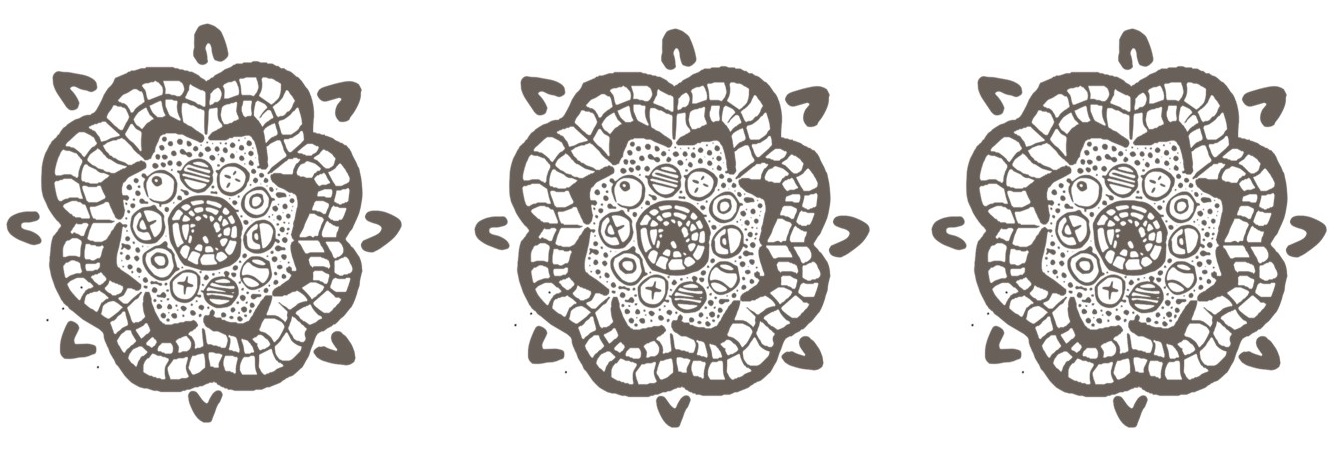
Events in this calendar can be added to your personal calendar by clicking each event heading.
Tasmanian Aboriginal Cultural Seasons
 Aboriginal cultural practices are determined by reading the signs and indicators from Country.
Aboriginal cultural practices are determined by reading the signs and indicators from Country.
Some significant dates and events for Aboriginal people are difficult to capture on the Gregorian Calander system as Aboriginal cultural practices are determined by reading the signs and indicators from Country. This is drawn from elements in the natural environment and consideration for the cycles of ecosystems, weather patterns and celestial bodies informing lore and cultural practice. These can vary significantly between regions across the continent due to the diverse range of climates and cultural landscapes that we experience. Here are some examples of Tasmanian Aboriginal cultural practices that are undertaken through reading Country.
Mutton birding
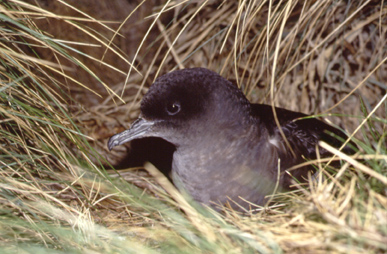 Tasmanian Aboriginal people continue to share a deep association with mutton-birds. The seasonal harvesting of mutton -bird is a continuous tradition that has taken place over thousands of years. Cultural practitioners eagerly await the arrival of the season and undertake the practice privately or on the Bass Strait Islands in commercial sheds. This provides an opportunity for family and community to share and continue knowledge and skills around this cultural practice.
Tasmanian Aboriginal people continue to share a deep association with mutton-birds. The seasonal harvesting of mutton -bird is a continuous tradition that has taken place over thousands of years. Cultural practitioners eagerly await the arrival of the season and undertake the practice privately or on the Bass Strait Islands in commercial sheds. This provides an opportunity for family and community to share and continue knowledge and skills around this cultural practice.
Mutton birding also provides economic benefits to the Tasmanian Aboriginal people because of the seasonal availability and the highly regarded benefits of the flesh, feathers and oil that the birds provide. Watching the signs from Country determines the beginning of mutton-bird season.
Please visit the supporting links below for more information:
- Natural Resources and Environment - Short-tailed Shearwater
- The Orb (Aboriginal Education Services) - Mutton birding
Image source: Natural Resources and Environment, Tasmania
Cultural burning
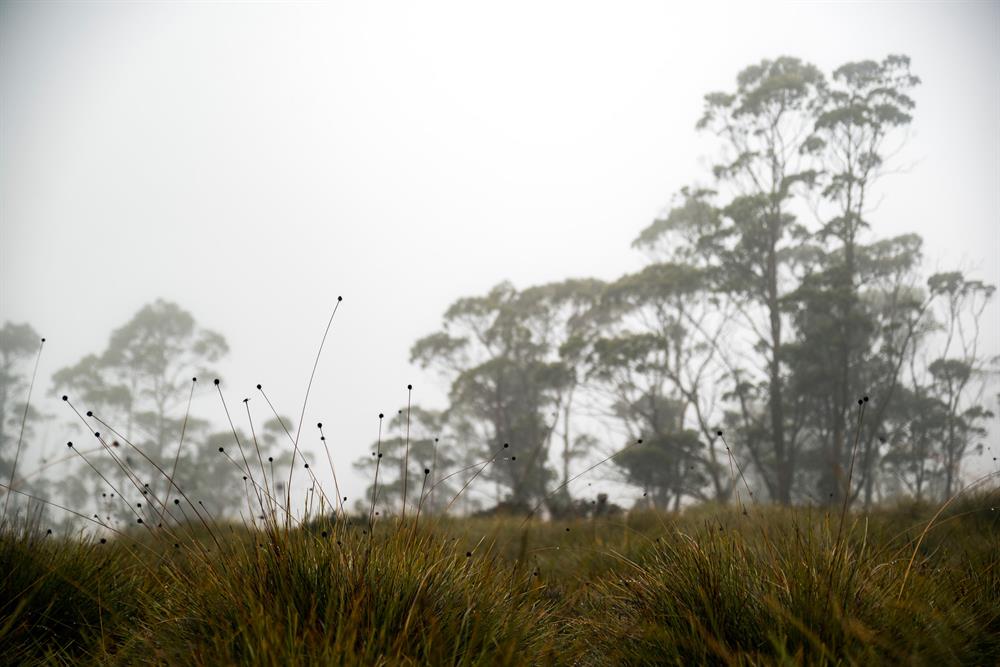 Tasmanian Aboriginal people care for and manage the landscape through cultural burning. Cultural burning is undertaken in various ecosystems that require fire to re-generate and re-populate native species of flora and fauna allowing them to flourish. The landscapes interdependence on fire has spanned over thousands of years due to Tasmanian Aboriginal influence and stewardship.
Tasmanian Aboriginal people care for and manage the landscape through cultural burning. Cultural burning is undertaken in various ecosystems that require fire to re-generate and re-populate native species of flora and fauna allowing them to flourish. The landscapes interdependence on fire has spanned over thousands of years due to Tasmanian Aboriginal influence and stewardship.
Many ecosystems have continued to evolve alongside fire. This includes pyrophytic species like button-grass moorlands requiring fire to complete its cycle of reproduction. Cultural burning has many benefits to the landscape like removing old and decaying plant matter and ensuring that new growth can occur by adding nutrients back into the soil for seed germination.
Cultural burns often occur in the cooler months of the calendar year by reading signs and indicators from Country. This includes reading the climate, wind speeds and moisture levels in the soil, signalling the optimum time to implement fire into the landscape. Country ultimately determines when it is the right time to introduce fire.
Please visit the supporting links below for more information:
- Aboriginal Heritage Tasmania - Cultural burning
- The Orb (Aboriginal Education Services) - Fire
- Tasmania Parks and Wildlife Service - Cultural Burning policy [PDF]
- Tasmania Parks and Wildlife Service - Cultural Burning procedures [PDF]
Image source: Tasmania Parks and Wildlife Service
![]()
January
26 JANUARY
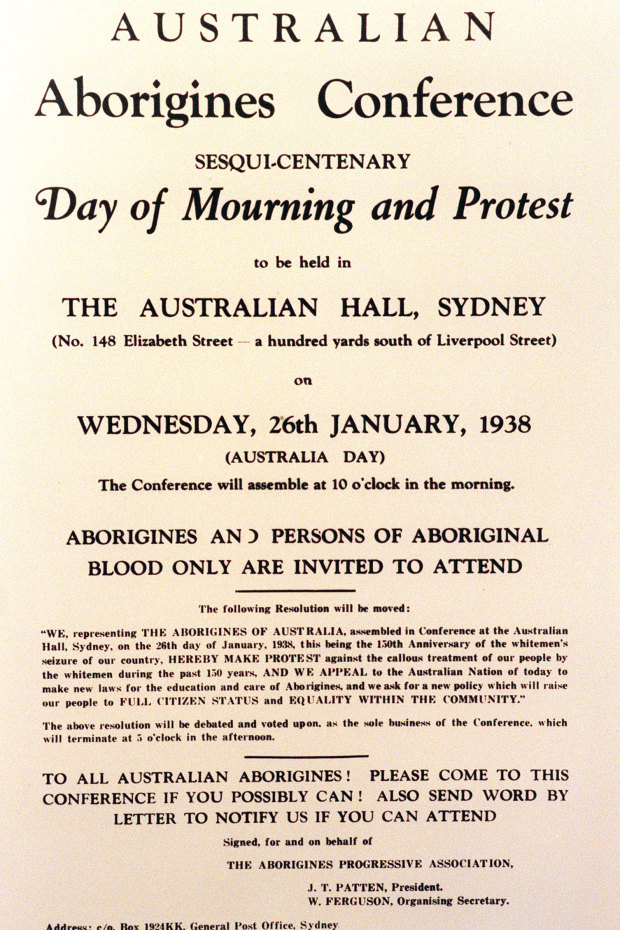 26 January is a day of much contention. This day is marked each year as a
26 January is a day of much contention. This day is marked each year as a  national public holiday and commemorates the ‘anniversary’ of the arrival of the ‘First Fleet’ in Australia.
national public holiday and commemorates the ‘anniversary’ of the arrival of the ‘First Fleet’ in Australia.
Each year, for many people, this day is about celebrating the values, freedoms and pastimes of this country. It’s a time for BBQs in the backyard, spending time with family and friends and proudly flying the flag. On the surface, this day may seem to be about unifying all Australians, and yet ironically, it’s a divisive day for many Aboriginal and non-Aboriginal People.
Many Aboriginal People see 26 January as a Day of Mourning, as a day that commemorates the invasion of the lands they had occupied for over 60,000 years. For some, it is a Day of Survival. This day was originally marked as 30 July back in 1915.
To find out more about 26 January and the current Australia Day debate, visit:
- Pride and Pain | There are two sides of the story of January 26th
- Australia Day 2021: The truth about January 26 - Sydney Morning Herald
- 10 things you should know about January 26 - NITV
Image source: Aboriginal Progressive Association, Australian Aborigines Conference: sesqui-centenary Day of Mourning and Protest (Sydney: Aboriginal Progressive Association, 1938). National Library of Australia.

DID YOU KNOW?
Captain Arthur Phillip did not first land in Australia on 26 January. On 13 May 1787, Captain Arthur Phillip led a fleet of 11 ships on a 252-day journey halfway around the world from Portsmouth, England to New South Wales. They were heading to Australia to create a new penal colony. The fleet arrived in Botany Bay on 18 January 1788.
January
putalina festival at putalina (Oyster Cove)
Please note: Due to ongoing uncertainty as a result of COVID we recommend you check directly with the Tasmanian Aboriginal Centre for information on any restrictions/cancellation of this event.
There is much devastation and sadness in the history of the Lands of Oyster Cove, now referred to as putalina.
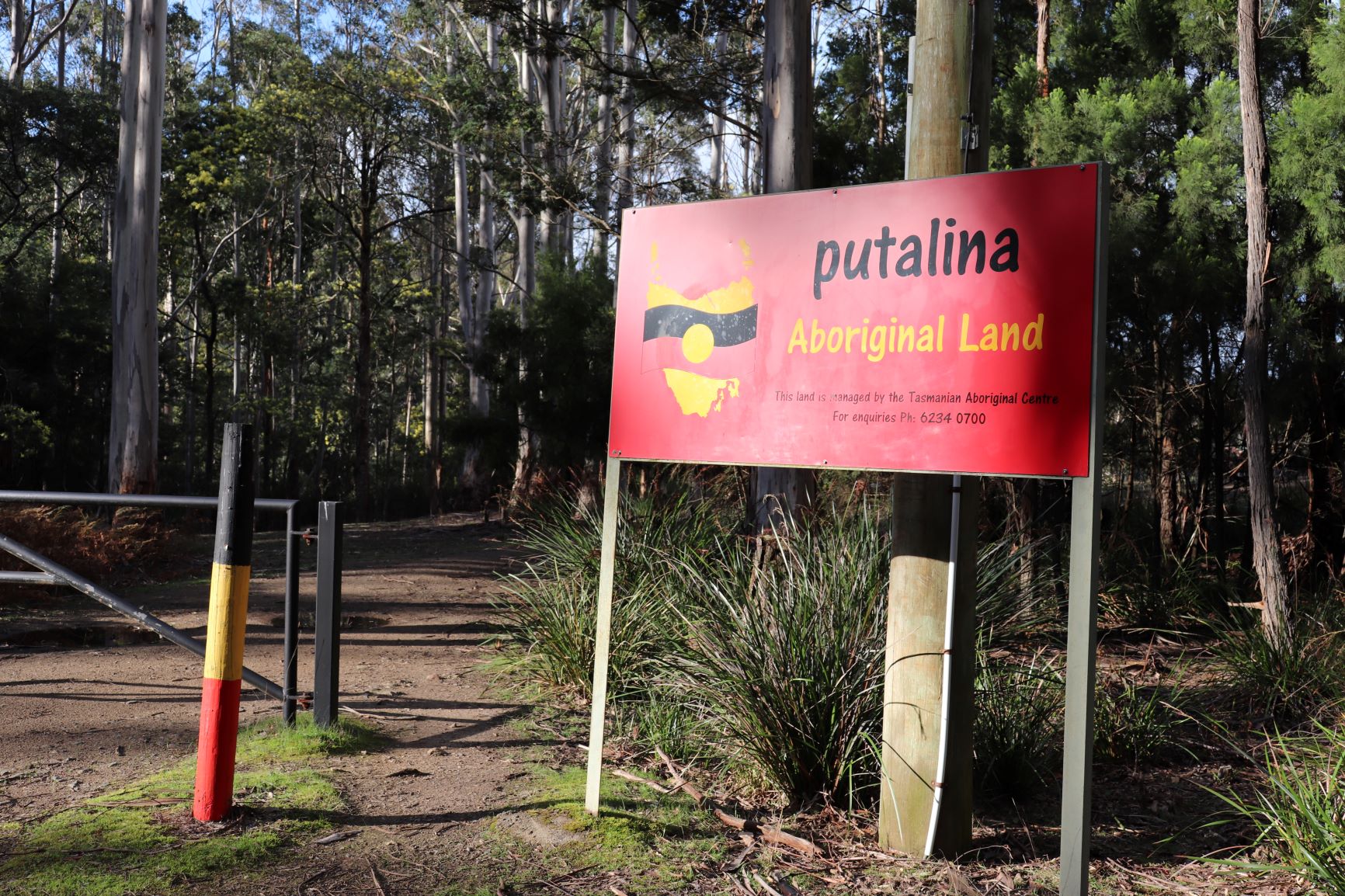
In 1847, after petitioning Queen Victoria, the surviving Tasmanian Aborigines at Wybalenna on Flinders Island were relocated to Oyster Cove, South of Hobart. Here they were housed in a condemned penal settlement considered unfit for convicts. Although conditions were harsh, the occupants continued to practice and pass on their culture. Oyster Cove was eventually closed in 1874.
 The Tasmanian Aboriginal Community reclaimed Oyster Cove as putalina in 1984, more than 100 years after it was abandoned. In 1995 the Tasmanian Government officially handed back the Land to the Aboriginal Community. Each year the putalina festival celebrates the vitality of Aboriginal Culture and Community.
The Tasmanian Aboriginal Community reclaimed Oyster Cove as putalina in 1984, more than 100 years after it was abandoned. In 1995 the Tasmanian Government officially handed back the Land to the Aboriginal Community. Each year the putalina festival celebrates the vitality of Aboriginal Culture and Community.
To learn more about putalina festival and the history of Oyster Cove Settlement visit the Tasmanian Aboriginal Centre website, or On The Convict Trail: Oyster Cove Aboriginal Settlement.
Image credit: putalina Land and signage. Photographer, Louise Adams.
![]()
February
13 February
Anniversary of the National Apology to Australia's Indigenous Peoples
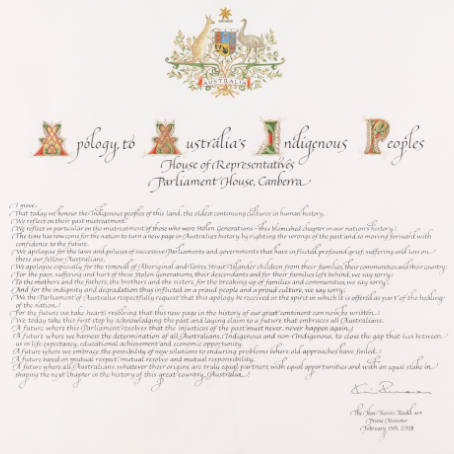 On this day in 2008, Prime Minister Kevin Rudd delivered the National Apology to Australia’s Aboriginal and Torres Strait Islander Peoples for the injustices of past government policies, particularly to the Stolen Generations.
On this day in 2008, Prime Minister Kevin Rudd delivered the National Apology to Australia’s Aboriginal and Torres Strait Islander Peoples for the injustices of past government policies, particularly to the Stolen Generations.
The full written Apology to Australia's Indigenous Peoples can be found on the Parliament of Australia website.
Video: After the Apology
Three Aboriginal Grandmothers fight to get their grandchildren returned to their families
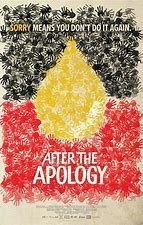
Suellyn thought Family and Community Services (FACS) would only remove Aboriginal children in extreme cases until her own grandchildren were taken. Hazel decided to take on the FACS system after her fourth grandchild was taken into state care. Jen Swan was raising her grandchildren until she was deemed unsuitable by FACS.
The rate of Indigenous child removal has increased at an exponential rate since Prime Minister Kevin Rudd delivered the Apology to Australia's Indigenous Peoples in 2008. Hazel started Grandmothers Against Removal (GMAR) as a response to the rising rates of child removal, along the way she has been joined by families across Australia in the battle to bring the kids home. Together they are not only taking on the system, they are changing it.
For more information, and to find out how you can watch After the Apology visit aftertheapology.com.
![]()
March
Ten Days is a biennial festival
the next festival is scheduled for 3-19 March 2023
 Ten Days on the Island is a biennial cultural festival held in Tasmania - lutruwita, the first festival was held in 2001. It is Tasmania's premier cultural event, and presents exhibitions, performances and community events spread across the state. Over time this event has established a significant place in the Australian arts calendar.
Ten Days on the Island is a biennial cultural festival held in Tasmania - lutruwita, the first festival was held in 2001. It is Tasmania's premier cultural event, and presents exhibitions, performances and community events spread across the state. Over time this event has established a significant place in the Australian arts calendar.
2021 saw Ten Days on the Island celebrate a landmark – 20 years of bringing remarkable arts experiences to lutruwita. A highlight was the Aboriginal Community artists who showcased their deep cultural connections and talents throughout the Ten Days. To read more about the Aboriginal performances and to keep up to date on future festivals visit the Ten Days on The Island website.
3rd Thursday in March
National Close the Gap Day
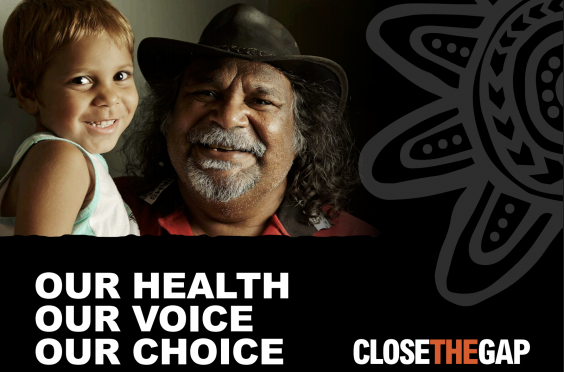 National Close the Gap Day is a national day of action to pledge support for achieving equitable health outcomes for Aboriginal and Torres Strait Islander Peoples.
National Close the Gap Day is a national day of action to pledge support for achieving equitable health outcomes for Aboriginal and Torres Strait Islander Peoples.
In March 2008, the then Prime Minister, Kevin Rudd and the Opposition Leader at that time, Brendan Nelson, signed the Close the Gap Statement of Intent at the Close the Gap Campaign’s National Indigenous Health Equality Summit.
The Close the Gap Statement of Intent includes a commitment to:
- develop a comprehensive, long-term plan of action that is; targeted to need, evidence-based, and capable of addressing the existing inequalities in health services in order to achieve equality of health status and life expectancy, between Aboriginal and Torres Strait Islanders and non-Indigenous Australians by 2030; and
- ensure the full participation of Aboriginal and Torres Strait Islander peoples and their representative bodies in all aspects of addressing their health needs.
Each year, National Close the Gap Day is acknowledged in workplaces, hospitals, schools and communities around Australia. Anyone can take part and make a difference. Join with over 220,000 other Australians and pledge your support to 'close the gap' by visiting the National Close the Gap Day website .
For more information on 'closing the gap', visit these websites:
- Close the Gap Indigenous Health Campaign - Australian Human Rights Commission
- National Close the Gap Day - FAQs
 Please note: There is a difference between the National Agreement on Closing the Gap, and the national day of action to Close the Gap. For a great, easy to understand explanation of the difference, download a copy of the Close the Gap and Closing the Gap - What's the difference (PDF, 266kb) fact sheet from the Royal Australian College of General Practitioners.
Please note: There is a difference between the National Agreement on Closing the Gap, and the national day of action to Close the Gap. For a great, easy to understand explanation of the difference, download a copy of the Close the Gap and Closing the Gap - What's the difference (PDF, 266kb) fact sheet from the Royal Australian College of General Practitioners.
21 March
International Day for the Elimination of Racial Discrimination
 The International Day for the Elimination of Racial Discrimination is observed annually on the day that police in Sharpeville, South Africa, opened fire and killed 69 people at a peaceful demonstration against apartheid "pass laws" in 1960.
The International Day for the Elimination of Racial Discrimination is observed annually on the day that police in Sharpeville, South Africa, opened fire and killed 69 people at a peaceful demonstration against apartheid "pass laws" in 1960.
In 1979, the United Nations, General Assembly decided that a week of solidarity with the peoples struggling against racism and racial discrimination, beginning on 21 March, would be organised annually.
 Whilst an international framework for fighting racism has been developed (guided by the International Convention on the Elimination of Racial Discrimination) it is still acknowledged that too many individuals, communities and societies suffer from the injustice and stigma that racism brings.
Whilst an international framework for fighting racism has been developed (guided by the International Convention on the Elimination of Racial Discrimination) it is still acknowledged that too many individuals, communities and societies suffer from the injustice and stigma that racism brings.
The United Nations General Assembly reiterated that all human beings are born free and equal in dignity and rights and have the potential to contribute constructively to the development and well-being of their societies. The general Assembly have emphasised that any doctrine of racial superiority is scientifically false, orally condemnable, socially unjust and dangerous and must be rejected, together with theories that attempt to determine the existence of separate human races.
You can find more information on the International Day for the Elimination of Racial Discrimination page on the United Nations website.
![]()
April
25 April
ANZAC Day
Acknowledging and celebrating Aboriginal ANZAC soldiers
 More than 1,000 Aboriginal and Torres Strait Islanders enlisted in World War 1, including a number of Tasmanian Aboriginal men. At the time, Indigenous Australians were not lawfully able to vote, marry a non-Aboriginal or Torres Strait Islander person, drink alcohol, own property, receive award wages or move freely around the country.
More than 1,000 Aboriginal and Torres Strait Islanders enlisted in World War 1, including a number of Tasmanian Aboriginal men. At the time, Indigenous Australians were not lawfully able to vote, marry a non-Aboriginal or Torres Strait Islander person, drink alcohol, own property, receive award wages or move freely around the country.
Many Aboriginal and Torres Strait Islander Peoples who tried to enlist were rejected on the grounds of race.
On ANZAC Day we honour and remember every soldier who has fought in any war, honouring and remembering our Aboriginal ancestors who fought the forgotten war in lutruwita – Tasmania, in an effort to retain their land, culture, language and way of life.
For more information, visit the Discovering Anzacs website at the National Archives of Australia,  and the Tasmanian Aboriginal Soldiers pages on the Tasmanian Government's Centenary of ANZAC website.
and the Tasmanian Aboriginal Soldiers pages on the Tasmanian Government's Centenary of ANZAC website.
Please note: Websites about Tasmanian Aboriginal soldiers contain images of deceased Aboriginal People which may offend Aboriginal and Torres Strait Islander Peoples.
![]()
May
26 May
National Day of Healing (Sorry Day)
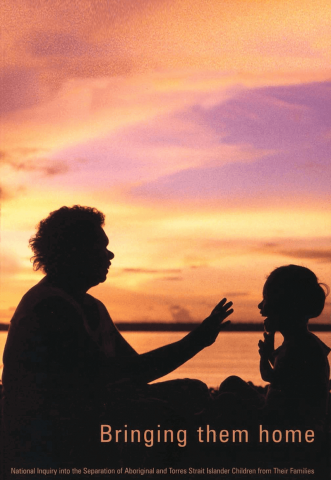 This is a significant day for Aboriginal and Torres Strait Islander peoples, and particularly for Stolen Generations survivors.
This is a significant day for Aboriginal and Torres Strait Islander peoples, and particularly for Stolen Generations survivors.
Commemorating ‘Sorry Day’ was one of the recommendations of the Bringing Them Home Report, which was tabled in Parliament on 26 May 1997. This report was the result of a National Inquiry into the forcible removal of Aboriginal and Torres Strait Islander children from their families, communities and cultural identity.
The first ‘Sorry Day’ was held in Sydney in 1998 and is now held nationally with memorials and commemorative events that honour the Stolen Generations. It is an opportunity to reflect on the sad and painful experiences of the Stolen Generations and recognise the healing and power of saying sorry.
For more information, visit the Australian Human Rights Commission Bringing Them Home website.
26 May 2017
Anniversary of the Uluru Statement from the Heart
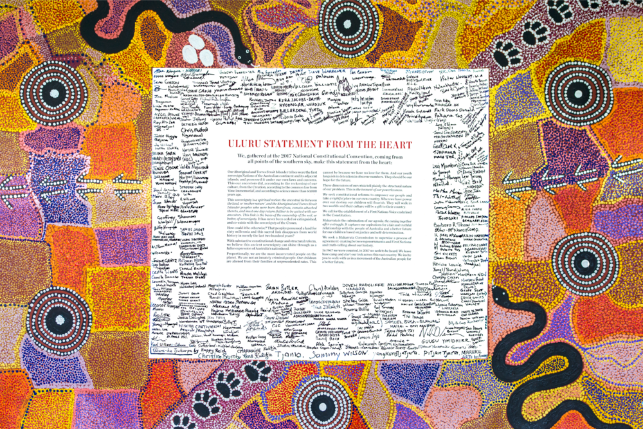 The Uluru Statement from the Heart was a national, First Nations Peoples (Aboriginal and Torres Strait Islander Peoples) consensus position on constitutional recognition, which came out of a constitutional convention of 250 Aboriginal and Torres Strait Islander delegates.
The Uluru Statement from the Heart was a national, First Nations Peoples (Aboriginal and Torres Strait Islander Peoples) consensus position on constitutional recognition, which came out of a constitutional convention of 250 Aboriginal and Torres Strait Islander delegates.
Held at the foot of Uluru in Central Australia on the lands of the Anangu people, the statement called for the establishment of a ‘First Nations Voice’ enshrined in the Australia Constitution and the establishment of a ‘Makarrata Commission’ to supervise agreement-making and truth-telling between governments and Aboriginal and Torres Strait Islander Peoples. The Uluru Statement was the culmination of 13 Regional Dialogues held around the country. It came after many decades of struggle by Aboriginal and Torres Strait Islander Peoples for recognition and calls for a stronger voice in their affairs.
A joint Select Committee on Constitutional Recognition relating to Aboriginal and Torres Strait Islander Peoples was appointed and presented its final report in November 2018 (with consideration to the recommendations from the Statement from the Heart). A copy of the final report is available from the Select Committee's webpage on the Parliament of Australia website.
In its final report, the Committee endorsed the proposal for a First Nations People’s Voice. The Committee also considered that their recommendations are significant steps for the Federal Parliament to discuss and consider, a bipartisan approach to advancing the cause of constitutional recognition.
The Committee also made recommendations in relation to truth-telling about Aboriginal and Torres Strait Islander history, traditions, and culture. The Committee hopes that a fuller understanding of Australia’s history will lead to a more reconciled nation.
27 May
Anniversary of the 1967 Referendum
Following decades of Aboriginal and non-Aboriginal activism, over 90% of all Australians voted in favour of amending two sections of the Australian Constitution.Sections of the Constitution subject to the referendum were:
Section 51 (xxvi)
The Parliament shall, subject to this Constitution, have power to make laws for the peace, order, and good government of the Commonwealth with respect to:
...The people of any race, other than the Aboriginal People in any State, for whom it is necessary to make special laws.
Section 127
In reckoning the numbers of the people of the Commonwealth, or of a State or other part of the Commonwealth, aboriginal natives should not be counted.
According to political historian, Scott Bennett, these sections were originally included in the Constitution because of the widely held beliefs that:
included in the Constitution because of the widely held beliefs that:
- Aboriginal People were 'dying out’ and, hence, would soon cease to be a factor in questions of representation.
- Indigenous people were not intellectually worthy of a place in the political system.
Following the 1967 Referendum, the words "…other than the Aboriginal People in any State…" in section 51(xxvi) and the whole of section 127 were removed, allowing for Aboriginal People to be included in the census, and giving Federal Parliament the power to make laws in relation to Aboriginal People.

Information source: Adapted from the Victorian Aboriginal Community Controlled Health Organisation INC website.
Further information on the 1967 Referendum can be found on the Parliament of Australia website Referendum page.
Image reference: From left to right: Mr. G Bryant, M.H.R., Senior Vice President of FCAATSI; Mrs. Faith Bandler, N.S.W Secretary; Mr. H. Holt, Prime Minister; Pastor D. Nicholls, Field Officer of Aborigines Advancement League; Mr. H Penrith, Executive Member of Council; Mrs. W.L. Bransor, S.A. Aborigines Advancement League; and Mr. W.C. Wentworth, M.H.R. Rights and advancement, May -June 1967, vol 9, cover, La Trobe Collection, State Library Victoria
27 May to 3 June
National Reconciliation Week
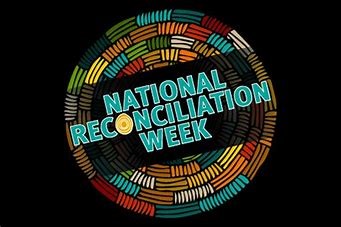 National Reconciliation Week (NRW) is a time for all Australians to learn about our shared histories, cultures, and achievement, and to explore how each of us can contribute to achieving reconciliation in Australia.
National Reconciliation Week (NRW) is a time for all Australians to learn about our shared histories, cultures, and achievement, and to explore how each of us can contribute to achieving reconciliation in Australia.
The dates for NRW remain the same each year, 27 May to 3 June. These dates commemorate two significant milestones in the reconciliation journey – the successful 1967 referendum and the High Court Mabo decision respectively.
In 1996, the council for Aboriginal Reconciliation launched Australia’s first National Reconciliation Week. In 2001, Reconciliation Australia was established to continue to provide national leadership on reconciliation. In the same year, approximately 300.000 people walked across Sydney Harbour Bridge as part of National Reconciliation week and subsequently across bridges in cities and towns across the Country to show their support for reconciliation. Today, National Reconciliation Week is celebrated nationally, in workplaces, schools and early learning services, and community organisations.
To find out more about Reconciliation Week go to www.reconciliation.org.au and Reconciliation Tasmania.

"Reconciliation must live in the hearts, minds, and actions of all Australians as we move forward. Creating a nation strengthened by respectful relationships between the wider Australian community, and Aboriginal and Torres Strait Islander Peoples." - Reconciliation Australia
![]()
June
3 June
Mabo Day
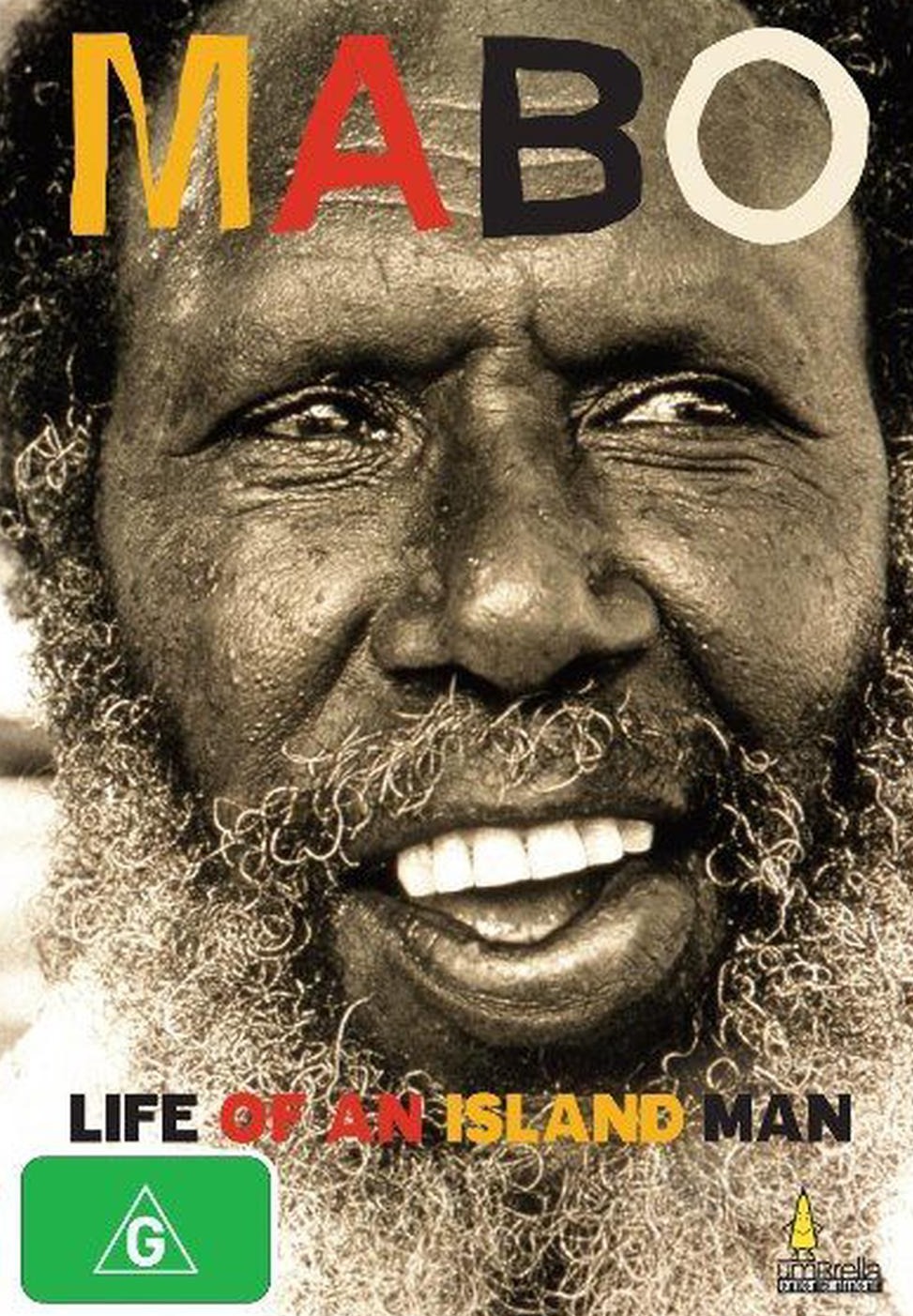 On 3 June 1992, the High Court of Australia decided that terra nullius should not have been applied to Australia. This decision – known as the Mabo decision – recognised that Aboriginal and Torres Strait Islander Peoples have rights to the Land – rights that existed before the British arrived and still exist today.
On 3 June 1992, the High Court of Australia decided that terra nullius should not have been applied to Australia. This decision – known as the Mabo decision – recognised that Aboriginal and Torres Strait Islander Peoples have rights to the Land – rights that existed before the British arrived and still exist today.
The Mabo decision was a turning point for the recognition of Aboriginal and Torres Strait Islander Peoples’ rights because it acknowledged their unique connection with the Land. It also led to the Australian Parliament passing the Native Title Act in 1993 which created a framework that recognises Aboriginal and Torres Strait Islander peoples have rights to, and interests in, certain Land because of their traditional laws and customs. It allows access to Land for living, traditional purposes, hunting or fishing and/or to teach laws and customs on the Land.
The following links provide more information on the Mabo Case and Mabo Day.
- Five things you should know about the Mabo decision - The University of Sydney
- 3 June: The Mabo decision factsheet - Reconciliation Australia.
MABO - Life of an island man (2012)
The remarkable life story of Eddie 'Koiki' Mabo
Eddie 'Koiki' Mabo a Torres Strait Islander who left school at the age of 15, yet spearheaded the High Court challenge that overthrew the fiction of terra nullius.
MABO is currently available to view on ABC iView.
Best documentary – Sydney Film Festival
Best documentary – AFI Awards
20 June 2014
Anniversary of Aboriginal Repatriation
For more than 150 years Aboriginal and Torres Strait Islander ancestral remains were stolen and sent to museums, universities, and private collections both in Australia and overseas. They were collected by medical officers, anatomists, ethnologists, anthropologists, and pastoralists. At the time of collection, ancestral remains from many Indigenous cultures around the world were ‘highly sought after’ for ‘scientific’ research and the value they were believed to add to collections.

"Our old people are an integral part of our story and our connection to our country and they deserve the right to be laid to rest here and they should never have been moved.” - Jarrod Edwards, Aboriginal delegate.
On 20 June 2014, Tasmanian Aboriginal representatives traveled to the United States of America to receive three ancestors from the Field Museum of Natural History in Chicago. The Museum acquired the ancestral remains in 1958 as part of a collection of ‘artifacts’ gathered in the late 19th century. The Aboriginal Community representatives participated in a ceremony and accompanied their ancestors home.
Second return of ancestral remains from Germany![]()
The Charité University Hospital in Berlin returned an Aboriginal ancestor from Robbins Island to Aboriginal Community members to take back to country, lutruwita. This is the second repatriation from the Charité and demonstrates the commitment from Germany to work with Aboriginal and Torres Strait Islander Communities to repatriate ancestral remains.
For more information on the Charité University Hospital repatriation, view the 2014 press release from then Attorney-General and Minister for the Arts, Senator, The Hon George Brandis QC at the Parliament of Australia website. To find out more information on both domestic and international repatriation, visit the International Repatriation Highlights page provided by the Australian Government's Department of Infrastructure, Transport, Regional Development and Communications (Office of the Arts).
![]()
July
NAIDOC Week
National Aboriginal & Islander Day Observance Committee
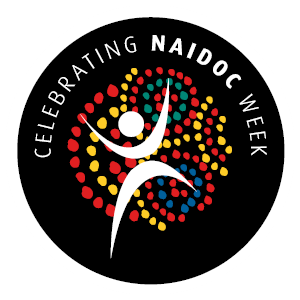 NAIDOC Week celebrations are held across Australia each July to celebrate the history, culture and achievements of Aboriginal and Torres Strait Islander Peoples. NAIDOC is celebrated not only in Aboriginal and Torres Strait Islander Communities, but by Australians from all walks of life. The week is a great opportunity to participate in a range of activities and to support your local Aboriginal and Torres Strait Islander community.
NAIDOC Week celebrations are held across Australia each July to celebrate the history, culture and achievements of Aboriginal and Torres Strait Islander Peoples. NAIDOC is celebrated not only in Aboriginal and Torres Strait Islander Communities, but by Australians from all walks of life. The week is a great opportunity to participate in a range of activities and to support your local Aboriginal and Torres Strait Islander community.
NAIDOC originally stood for ‘National Aborigines and Islanders Day Observance Committee’. This committee was once responsible for organising national activities during NAIDOC Week and its acronym has since become the name of the week itself.
To find out more about the origins and history of NAIDOC Week, the dates, theme for the current year and planned events, visit the NAIDOC Week website. If you are thinking about organising your own NAIDOC Week event, suggestions for ways to celebrate can be found on the Plan Your Event page.
23 July
Anniversary of the 2000 Reconciliation Tasman Bridge Walk
More than 20,000 Tasmanians took part in the Aboriginal  Reconciliation Walk across Hobart's Tasman Bridge in one of the State's largest ever public rallies.
Reconciliation Walk across Hobart's Tasman Bridge in one of the State's largest ever public rallies.
Twenty years ago, in a monumental display of support for reconciliation, around 250,000 Australians walked across the Sydney Harbour Bridge. The People’s Walk for Reconciliation (as the bridge walk was titled), had a profound impact on those who participated, and a roll-on effect around the country.

By the end of 2000, the walks for reconciliation held right across the country became the largest display of public support for a single cause in Australian history. More information can be found on Reconciliation Australia's When Australia Walked the Talk: The 2000 Reconciliation Bridge Walks webpage.
![]()
August
4 August
National Aboriginal and Torres Strait Islander Children's Day
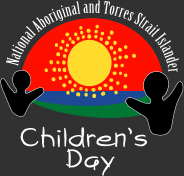 National Aboriginal & Torres Strait Islander Children’s Day celebrates the strengths and culture of Aboriginal and Torres Strait Islander children and their families.
National Aboriginal & Torres Strait Islander Children’s Day celebrates the strengths and culture of Aboriginal and Torres Strait Islander children and their families.
In 1988, the first National Aboriginal and Islander Children’s Day was established on 4 August and was set against the backdrop of protest led by Aboriginal and Torres Strait Islander people and their supporters during the bicentennial year. Aboriginal and Torres Strait Islander peoples felt a day was needed to celebrate Aboriginal and Torres Strait Islander children; to give them confidence and make them feel proud and included.
The 4th of August was historically used to communally celebrate the birthdays of Aboriginal and Torres Strait Islander children who were taken from their families at a young age, without knowing their birthday – the Stolen Generations.
Despite a majority of Aboriginal and Torres Strait Islander children thriving and growing up strong in their culture, with support from their families and communities, a significant number of children continue to face ongoing challenges, stemming from colonisation/invasion and its effects. This includes discrimination, poverty, systemic removal, intergenerational trauma, loss and grief, dislocation from Land and culture, and community disempowerment.
in their culture, with support from their families and communities, a significant number of children continue to face ongoing challenges, stemming from colonisation/invasion and its effects. This includes discrimination, poverty, systemic removal, intergenerational trauma, loss and grief, dislocation from Land and culture, and community disempowerment.
For Aboriginal children safety, wellbeing and development are closely linked to the strengths of their connections with family, community, culture, language and Country.
To find out more information visit the Aboriginal Children's Day website.
9 August
International Day of the World's Indigenous Peoples
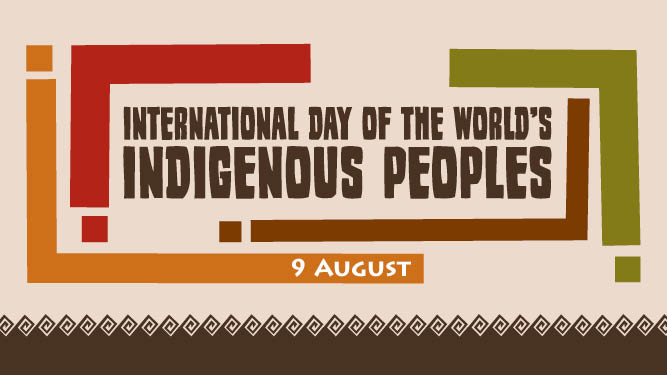 Indigenous peoples are inheritors and practitioners of unique cultures and ways of relating to people and the environment. They have retained social, cultural, economic and political characteristics that are distinct from those of the dominant societies in which they live. Despite their cultural differences, indigenous peoples from around the world share common problems related to the protection of their rights as distinct peoples.
Indigenous peoples are inheritors and practitioners of unique cultures and ways of relating to people and the environment. They have retained social, cultural, economic and political characteristics that are distinct from those of the dominant societies in which they live. Despite their cultural differences, indigenous peoples from around the world share common problems related to the protection of their rights as distinct peoples.
Indigenous peoples have sought recognition of their identities, their way of life and their right to traditional lands, territories and natural resources for years. Yet, throughout history, their rights have been violated. Indigenous peoples today, are arguably among the most disadvantaged and vulnerable groups of people in the world. The international community now recognises that special measures are required to protect their rights and maintain their distinct cultures and way of life.
In order to raise awareness of the needs of these population groups, every 9 August commemorates the International Day of the World’s Indigenous Peoples, chosen in recognition of the first meeting of the United Nations Working Group on Indigenous Populations held in Geneva in 1982.
More information can be found on the United Nations International Day of the World's Indigenous Peoples website.
13 August 1997
Anniversary of the Apology to Aboriginal People
by the Tasmanian Government
The Tasmanian Parliament formally apologised to the Stolen Generations on 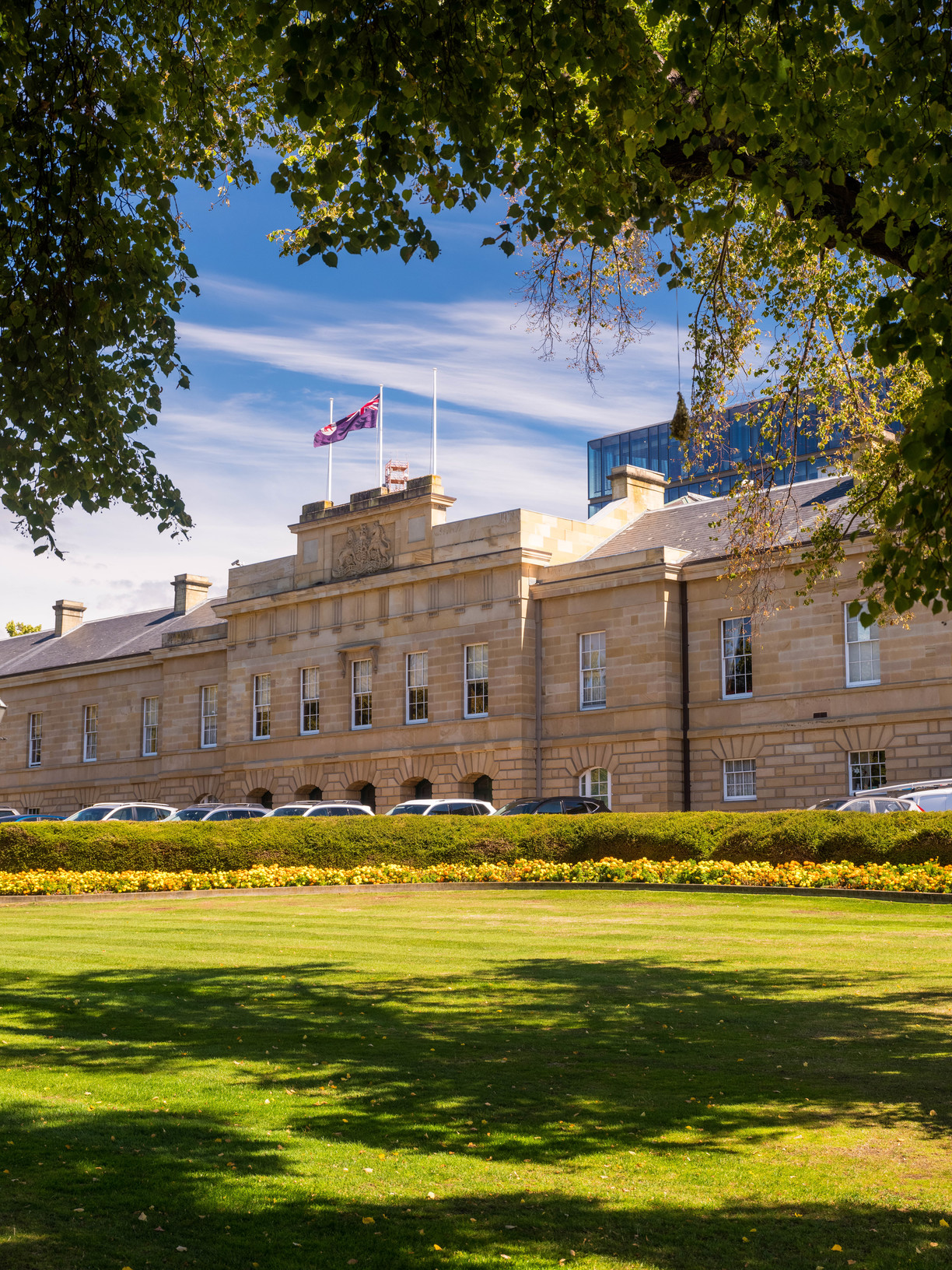 13 August 1997. The Apology to Aboriginal People was made by the then Premier, Tony Rundle, in response to the Bringing Them Home Report.
13 August 1997. The Apology to Aboriginal People was made by the then Premier, Tony Rundle, in response to the Bringing Them Home Report.
An Aboriginal Elder, Annette Peardon, replied to the apology. This was the first time anywhere in Australia that an Aboriginal Person had been invited to address Parliament. An audio recording of Annette Peardon's response is available from the ABC Local website.
In 2006 the Tasmanian Parliament led the way by becoming the first State or Territory to back their apology with action, unanimously passing laws to provide monetary compensation for the Stolen Generations.
Image credit: Parliament House, Tasmania. Photographer, Alastair Bett
![]()
September
13 September
Anniversary of the United Nations
Declaration on the Rights of Indigenous Peoples
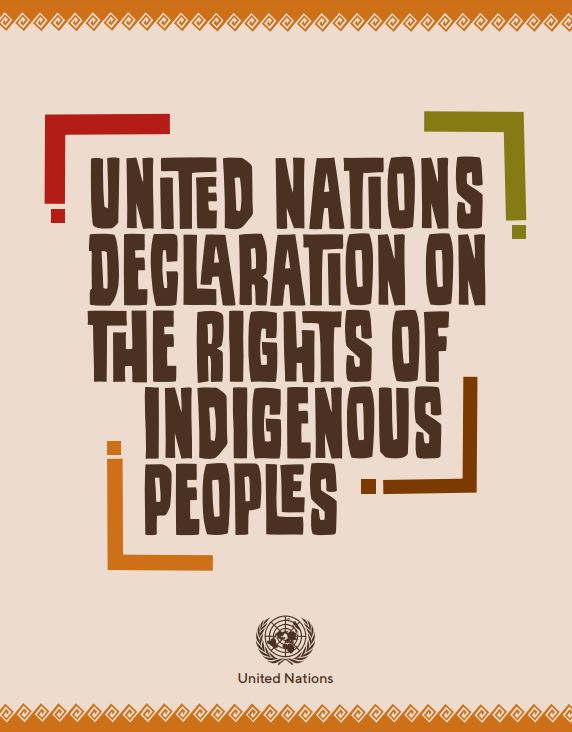
The United Nations Declaration on the Rights of Indigenous Peoples (UNDRIP) was adopted by the General Assembly on Thursday, 13 September 2007, by a majority of 144 states in favour, four votes against (Australia, Canada, New Zealand and the United States) and 11 abstentions (Azerbaijan, Bangladesh, Bhutan, Burundi, Colombia, Georgia, Kenya, Nigeria, Russian Federation, Samoa and Ukraine). Years later the four countries that voted against have reversed their position and now support the UN Declaration.
 Nine years have passed since the UN Declaration on the Rights of Indigenous Peoples. Many of the rights in the Declaration require new approaches to global issues such as development, decentralisation and multicultural democracy. In order to achieve full respect for diversity, countries will need to adopt participatory approaches to Indigenous issues, which will require effective consultations and the building of partnerships with Indigenous peoples.
Nine years have passed since the UN Declaration on the Rights of Indigenous Peoples. Many of the rights in the Declaration require new approaches to global issues such as development, decentralisation and multicultural democracy. In order to achieve full respect for diversity, countries will need to adopt participatory approaches to Indigenous issues, which will require effective consultations and the building of partnerships with Indigenous peoples.
Information on, and a copy of the Declaration can be found on the United Nations Declaration on the Rights of Indigenous Peoples website
![]()
October
18 October 1847
Anniversary of the closure of Wybalenna, Flinders Island
Wybalenna is one of the most significant Aboriginal historical places in Tasmania. It is located on the west coast of Flinders Island, the largest island in the eastern part of Bass Strait.
George Robinson’s so-called ‘friendly mission’ from 1829 to 1831, and the Black Line in 1830, led to an agreement – or, some say, a treaty – between Aboriginal clan leaders and Governor Arthur in October 1831. The agreement led to the progressive removal of Aboriginal People from mainland Tasmania from 1831 to 1835. The forced exile of Tasmanian Aboriginal People to Wybalenna on Flinders Island paved the way for the unimpeded ongoing invasion of Tasmanian Aboriginal Lands.
Following the departure of George Robinson to Port Philip (now Victoria) in February 1839, there was a dramatic reduction in resources provided to the Settlement. Most of the convicts and soldiers were removed. Doctor Jeanneret was appointed Commandant in 1842. Children were again removed to the Orphan School against their parents’ wishes. In February 1846, Walter Arthur and other Aboriginal People petitioned Queen Victoria to prevent Jeanneret returning. In spite of the petition, Jeanneret was reinstated. Conflict escalated and in 1847, Governor Denison ordered the closure of Wybalenna.
there was a dramatic reduction in resources provided to the Settlement. Most of the convicts and soldiers were removed. Doctor Jeanneret was appointed Commandant in 1842. Children were again removed to the Orphan School against their parents’ wishes. In February 1846, Walter Arthur and other Aboriginal People petitioned Queen Victoria to prevent Jeanneret returning. In spite of the petition, Jeanneret was reinstated. Conflict escalated and in 1847, Governor Denison ordered the closure of Wybalenna.
By the time the settlement closed in 1847, approximately 130 people had died at Wybalenna. On 18 October 1847, the remaining 14 men, 23 women and 10 children were removed from Wybalenna and taken to the former convict station at putalina/Oyster Cove.
More information on Wybalenna can be found in the Aboriginal Heritage Tasmania fact sheet, Historical Places - Wybalenna (PDF, 258kb).
Image credit: Wybalenna Chapel, Flinders Island. Photographer: Tanya Harper.
31 October 1975
Anniversary of the Racial Discrimination Act 1975 (Cwth)
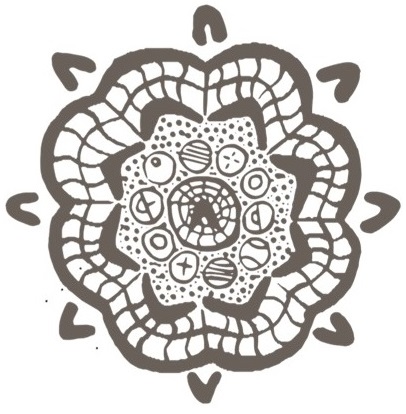
In October 1975, at a ceremony for the proclamation of the Racial Discrimination Act 1975 (the Act), then Prime Minister Gough Whitlam described the legislation as "...a historic measure...", which aimed to "...entrench new attitudes of tolerance and understanding in the hearts and minds of the people."
The Act was Australia’s first federal human rights and discrimination law. Enacted shortly after the formal abandonment of the While Australia Policy, it was also a legislative expression of a new commitment to multiculturalism.
The Act promotes equality between people of different background, and it protects people from unfair treatment or vilification on the basis of their race, colour, descent, or national or ethnic origin. The Race Discrimination Commissioner works with governments, partners, education providers, the media and workplaces to help organisations understand their rights and meet their legal responsibilities.
Find out more about Racial Discrimination on the Australian Human Rights Commission website.
![]()
November
November 1973
Tasmanian Aboriginal Centre
Tasmania's oldest established Aboriginal organisation
 The Tasmanian Aboriginal Centre (TAC) is the oldest and largest Aboriginal Community organisation and opened its doors in the early 1970s. It was incorporated as the Aboriginal Information Service in November 1973 and changed its name to Tasmanian Aboriginal Centre (TAC) in August 1977, and officially to Tasmanian Aboriginal Corporation in 2016, but still trading as the Tasmanian Aboriginal Centre.
The Tasmanian Aboriginal Centre (TAC) is the oldest and largest Aboriginal Community organisation and opened its doors in the early 1970s. It was incorporated as the Aboriginal Information Service in November 1973 and changed its name to Tasmanian Aboriginal Centre (TAC) in August 1977, and officially to Tasmanian Aboriginal Corporation in 2016, but still trading as the Tasmanian Aboriginal Centre.
The TAC has branches in Burnie, Hobart and Launceston and provides Aboriginal Community members a direct voice in the management and delivery of a comprehensive range of services. These include health, housing, and a range of family and cultural support programs. The Tasmanian Aboriginal Centre continues to be a leader in the ongoing fight for social justice for all Tasmanian Aboriginal People.
Some of the Tasmanian Aboriginal Centre’s achievements include:
- negotiation of Aboriginal Land returns in 1995, 1999, 2005;
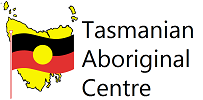
- return of ancestral remains from overseas and Australian institutions;
- legislative recognition of Aboriginal Cultural fishing rights;
- apology to the Tasmanian Stolen Generations;
- financial compensation to members of the Stolen Generations;
- negotiation of land purchases for community ownership;
- establishment of a range of Aboriginal Community services;
- retrieval and revival of Tasmanian Aboriginal Language;
- improved accountability of Aboriginal heritage protection;
- establishment of the only Aboriginal Registered Training Organisation in Tasmania; and
- establishment of Tasmanian government services to members of the Aboriginal Community.
For more information visit the Tasmanian Aboriginal Centre website.
Please note: A range of other Aboriginal organisations have been established in response to their localised community needs. Please refer to Natural Resources and Environment Tasmania's Register of Aboriginal Community Organisations [PDF].
![]()
December
4 December 2021
Mannalargenna Day (first Saturday in December each year)
Mannalargenna was a leader of the Pairrebeenne/Trawlwoolway 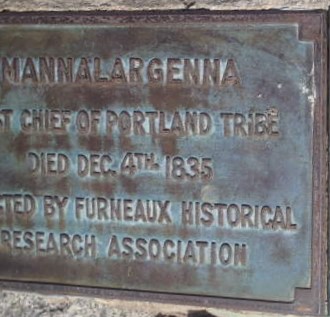 clan of the Coastal Plains nation, revered for having powers over the wind. He was also a formidable warrior who reportedly danced to avoid spears thrown in clan attack and was a guerrilla fighter during the colonial wars. In 1829 he freed four Aboriginal women and a boy from John Batman's house where they had been held captive for a year.
clan of the Coastal Plains nation, revered for having powers over the wind. He was also a formidable warrior who reportedly danced to avoid spears thrown in clan attack and was a guerrilla fighter during the colonial wars. In 1829 he freed four Aboriginal women and a boy from John Batman's house where they had been held captive for a year.
In 1830 Mannalargenna met George Augustus Robinson, whom the colony’s governor (George Arthur) had commissioned to persuade the remaining first people to self-exile to the islands off Tasmania. Robinson told Mannalargenna that if he helped persuade the clans to move away from the homelands, it would be temporary. On 6 August 1831, Robinson promised they could one day return to their ancestral lands and live, hunt and practise their culture in safety. The same promise was repeated to three other clan leaders that year: Maulterheerlargenna of the Stoney Creek nation; Tongerlongter of the Oyster Bay nation; and Montpelliater of the Big River nation.
As a powerful leader and negotiator, Mannalargenna agreed to accompany Robinson on his mission. After four years assisting Robinson, in late 1835 Mannalargenna himself moved to the Wybalenna Aboriginal establishment on Flinders Island. Ultimately, Robinson broke his promise. As a symbol of the betrayal, Mannalargenna cut off his long-ochred hair and beard. On 4 December 1835 he died of pneumonia. (Information sourced from Breathing in Mannalargenna)
The National Museum Australia website provides an account by Emma Lee, a member of Melythina Tiakana Warrana, on the importance of ochre.

Melythina Tiakana Warrana (Heart of Country) Aboriginal Corporation supports people to understand and reconnect with the culture and history of north-east Tasmania and welcomes people to Tebrakunna Country, to honour the memory of their revered ancestor Mannalargenna and their ancestral grandmothers who came from Tebrakunna Country: Woretmoeteyenner, Wyberlooberer, Teekoolterme (Nimerenna), Wapperty (Woonoteahcootameena), Tarenooterrer, Poolrerrener (Bullrub), Wottecowwidyer and Pleenperrenner (Mother Brown).
Image credit: Mannalargenna commemorative plaque. Photographer: Tanya Harper.
6 December 2016
Anniversary of more Aboriginal ancestral remains returning to Tasmania
Tasmanian Aboriginal delegates brought back three ancestors from Canberra on  6 December 2016. They had been traditionally buried about 2,000 years ago, and their resting place was disrupted in the mid-20th Century and their remains taken to Canberra to be studied. They have been stored at an institution there ever since.
6 December 2016. They had been traditionally buried about 2,000 years ago, and their resting place was disrupted in the mid-20th Century and their remains taken to Canberra to be studied. They have been stored at an institution there ever since.
“The Tasmanian Aboriginal Centre negotiated the repatriation of our people’s remains to Tasmania so we can return them to their tribal lands and their spirits can be put to rest”. - Tasmanian Aboriginal Centre Repatriation Notice (PDF, 525kb).
The Tasmanian Aboriginal Centre has actively campaigned for the return of ancestral remains for over 40 years and has been successful in achieving many repatriations from Tasmanian, national and international museums, and other institutions.
The Examiner Newspaper covered the event and their account can be viewed online: Tasmanian Aboriginal ancestors repatriated to Launceston.
December 1995
The Aboriginal Lands Act 1995 (Tasmania) and the
establishment of the Aboriginal Land Council of Tasmania
The significance of the return of land to Aboriginal People

Tasmanian Aboriginal People continue to have a profound connection to the landscape. Connection to country, including land, sky, sea and water and having a responsibility to care for it, are central to Tasmanian Aboriginal Culture and Identity. For Aboriginal People, this relationship to Land and Country is much deeper than contemporary notions of land ownership and use.
The Aboriginal Lands Act 1995 (the Act), promotes reconciliation by granting Aboriginal People certain parcels of land of historic or cultural significance. The Act is the key Tasmanian legislation providing for the return of land and its management. The Act establishes the Aboriginal Land Council of Tasmania (ALCT), as a statutory authority with responsibility for the use and sustainable management of statutorily defined Aboriginal Land, which it holds in perpetuity for all Tasmanian Aboriginal People.
The return of land to Tasmania’s Aboriginal People has been an important way to progress reconciliation between Aboriginal and non-Aboriginal Tasmanians. To date, the Tasmanian Government has returned 55,617 hectares of culturally and historically significant Crown Land (or approximately 1% of all Tasmanian lands) to the Aboriginal Community. This includes significant sites at putalina (Oyster Cove), Risdon Cove, Wybalenna and Cape Barren Island (land vested, or acquired through the Act, or involving the Indigenous Land Corporation). A full list of land returned to date can be viewed by downloading a copy of the Aboriginal Land (lutruwita) map (PDF, 930kb), from the Tasmanian Aboriginal Centre.
Since the initial return of Land in 1995, only a small number of additional land parcels have been returned to the Tasmanian Aboriginal Community under the Act. In 2012 and 2013 attempts to return Crown Land, including sites at larapuna (Eddystone Point) and Rebecca Creek, failed to pass the Legislative Council. The political and social landscape in which land return and management is progressed in Tasmania has changed significantly since the Act passed in 1995. It has become more common for some Aboriginal organisations to enter into their own property acquisition arrangements with partner organisations outside of the Act. For example, Kings Run, a 338-hectare site between the Arthur River and Marrawah, was purchased by the Aboriginal Land Council of Tasmania (ALCT) through a collaborative funding arrangement with other organisations. This approach has occurred with other ALCT property acquisitions.
have been returned to the Tasmanian Aboriginal Community under the Act. In 2012 and 2013 attempts to return Crown Land, including sites at larapuna (Eddystone Point) and Rebecca Creek, failed to pass the Legislative Council. The political and social landscape in which land return and management is progressed in Tasmania has changed significantly since the Act passed in 1995. It has become more common for some Aboriginal organisations to enter into their own property acquisition arrangements with partner organisations outside of the Act. For example, Kings Run, a 338-hectare site between the Arthur River and Marrawah, was purchased by the Aboriginal Land Council of Tasmania (ALCT) through a collaborative funding arrangement with other organisations. This approach has occurred with other ALCT property acquisitions.
For more information, access a copy of the Aboriginal Lands Act 1995, or visit the Aboriginal Land Council of Tasmania Facebook page,
10 December
Human Rights Day

Human Rights Day is observed every year on 10 December - the day the United Nations General Assembly adopted, in 1948, the Universal Declaration of Human Rights (UDHR) (PDF, 96kb).
The UDHR is a milestone document that proclaims the inalienable rights which everyone is entitled to as a human being - regardless of race, colour, religion, sex, language, political or other opinion, national or social origin, property, birth or other status. Available in more than 500 languages, it is the most translated document in the world.
More information on the Universal Declaration of Human Rights and Human Rights Day can be found on the United Nations website.
13 December 2017
Anniversary of the formation of the
Tasmanian Regional Aboriginal Communities Alliance (TRACA)
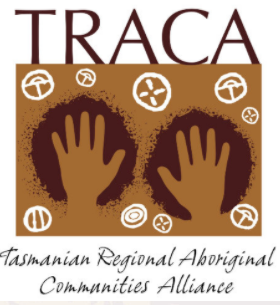 Seven Aboriginal organisations, covering a wide geographic area of Tasmania, including the Furneaux Islands, came together to form the Tasmanian Regional Aboriginal Communities Alliance (TRACA). TRACA was developed to provide a mechanism to engage and advise Government at all levels in regard to affairs affecting Aboriginal Tasmanians. It is designed to be inclusive and to support and build the capacity of placed based Aboriginal Community decision-making. A Statement of Intent between the Tasmanian Government TRACA was signed on 13 December 2017.
Seven Aboriginal organisations, covering a wide geographic area of Tasmania, including the Furneaux Islands, came together to form the Tasmanian Regional Aboriginal Communities Alliance (TRACA). TRACA was developed to provide a mechanism to engage and advise Government at all levels in regard to affairs affecting Aboriginal Tasmanians. It is designed to be inclusive and to support and build the capacity of placed based Aboriginal Community decision-making. A Statement of Intent between the Tasmanian Government TRACA was signed on 13 December 2017.
TRACA welcome a broad range of Aboriginal Community-controlled organisations with different backgrounds and interests. Current TRACA membership consists of the following organisations: Circular Head Aboriginal Corporation in the northwest region, Flinders Island Aboriginal Association Inc on Flinders Island, Melythina tiakana warrana Aboriginal Corporation in the northeast, Parrdarrama Pungenna Aboriginal Corporation in the east coast and Tasman Peninsula, Six Rivers Aboriginal Corporation in the central and northern coast, South East Tasmania Aboriginal Corporation in the southeast and Weetapoona Aboriginal Corporation on Bruny Island.
For more information, visit the TRACA website.
18 December 1998
Anniversary of the enactment of
Tasmania's Anti-Discrimination Act 1998
![]() The enactment of the Anti-Discrimination Act 1998 (Tasmania) was seen as a significant achievement in the state of Tasmania with respect to anti-discrimination legislation, and came after years of lobbying.
The enactment of the Anti-Discrimination Act 1998 (Tasmania) was seen as a significant achievement in the state of Tasmania with respect to anti-discrimination legislation, and came after years of lobbying.
Although the Tasmanian Anti-Discrimination Commission, headed by Dr Jocelynne Scutt, commenced office soon after on 10 December 1999, much of the groundwork was laid some twenty years ago from its inception in the Tasmanian Parliament back in 1978. During this period, Tasmania, unlike other Australian jurisdictions, was characterised by intense public debate and lobbying between political parties and community groups over the merits of anti-discrimination laws.
To learn about the evolution of Tasmania's anti-discrimination law, you can read From Conflict to Convergence: The Evolution of Tasmanian Anti-discrimination Law" [2001], by Gus Bernardi and published in the Australian Journal of Human Rights.
To find out more about your legal rights and/or responsibilities under the Anti-discrimination Act 1998, visit Equal Opportunity Tasmania.
![]()
